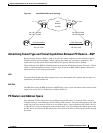
Implementing MPLS VPNs over IP Tunnels on Cisco IOS XR Software
Prerequisites for Configuring MPLS VPNs over IP Tunnels
MPC-274
Cisco IOS XR MPLS Configuration Guide
OL-12284-01
Prerequisites for Configuring MPLS VPNs over IP Tunnels
The following prerequisites are required to implement MPLS VPNs over IP Tunnels:
• You must be in a user group associated with a task group that includes the proper task IDs for
–
BGP commands
–
MPLS commands (generally)
–
MPLS Layer 3 VPN commands
For detailed information about user groups and task IDs, see the Configuring AAA Services on Cisco IOS
XR Software module of Cisco IOS XR System Security Configuration Guide.
Restrictions for Configuring MPLS VPNs over IP Tunnels
The following restrictions apply when you configure MPLS VPNs over IP tunnels:
• MPLS forwarding cannot be enabled on a provider edge (PE) router.
Information About MPLS VPNs over IP Tunnels
To implement MPLS VPNs over IP Tunnels, you must understand the following concepts:
• Overview: MPLS VPNs over IP Tunnels, page MPC-274
• Advertising Tunnel Type and Tunnel Capabilities Between PE Routers—BGP, page MPC-275
• PE Routers and Address Space, page MPC-275
• Packet Validation Mechanism, page MPC-276
• Quality of Service Using the Modular QoS CLI, page MPC-276
• BGP Multipath Load Sharing for MPLS VPNs over IP Tunnels, page MPC-276
• Inter-AS and CSC Support over IP Tunnels, page MPC-277
Overview: MPLS VPNs over IP Tunnels
Traditionally, VPN services are deployed over IP core networks using MPLS, or L2TPv3 tunnels using
point-to-point links. However, an L2TPv3 multipoint tunnel network allows L3VPN services to be
carried through the core without the configuration of MPLS.
L2TPv3 multipoint tunneling supports multiple tunnel endpoints, which creates a full-mesh topology
that requires only one tunnel to be configured on each PE router. This permits VPN traffic to be carried
from enterprise networks across cooperating service provider core networks to remote sites.
Figure 24 illustrates the topology used for the configuration steps.


















